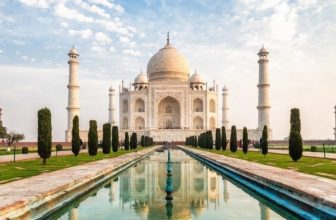Monday Flashback Story – Red Fort, Agra – The Sustainable fort from Mughal Era!
Agra Red Fort is a historical fort in the city of Agra in India. It was the main residence of the emperors of the Mughal Dynasty until 1638 when the capital was shifted from Agra to Delhi. Before capture by the British, the last Indian rulers to have occupied it were the Marathas. In 1983, the Agra fort was inscribed as a UNESCO World Heritage Site. It is about 2.5 km northwest of its more famous sister monument, the Taj Mahal. The fort can be more accurately described as a walled city.
Like the rest of Agra, the history of Agra’s Red Fort prior to Mahmud Ghaznavi’s invasion is unclear. However, in the 15th century, the Chauhan Rajputs occupied it. Soon after, Agra assumed the status of capital when Sikandar Lodi (A.D. 1487–1517) shifted his capital from Delhi and constructed a few buildings in the pre-existing Fort at Agra. After the first battle of Panipat (A.D. 1526) Mughals captured the fort and ruled from it. In A.D. 1530, Humayun was crowned in it. The Fort got its present appearance during the reign of Akbar (A.D. 1556–1605).
After the First Battle of Panipat in 1526, Babur stayed in the fort, in the palace of Ibrahim Lodi. He later built a baoli (step well) in it. His successor, Humayun, was crowned in the fort in 1530. He was defeated at Bilgram in 1540 by Sher Shah Suri. The fort remained with the Suris till 1555, when Humayun recaptured it. Adil Shah Suri’s general, Hemu, recaptured Agra in 1556 and pursued its fleeing governor to Delhi where he met the Mughals in the Battle of Tughlaqabad.
The 380,000 m2 (94-acre) fort has a semicircular plan, its chord lies parallel to the river Yamuna and its walls are seventy feet high. Double ramparts have massive circular bastions at intervals, with battlements, embrasures, machicolations and string courses. Four gates were provided on its four sides, one Khizri gate opening on to the river.[citation needed]
Two of the fort’s gates are notable: the “Delhi Gate” and the “Lahore Gate.” The Lahore Gate is also popularly also known as the “Amar Singh Gate,” for Amar Singh Rathore.
The monumental Delhi Gate, which faces the city on the western side of the fort, is considered the grandest of the four gates and a masterpiece of Akbar’s time. It was built circa 1568 both to enhance security and as the king’s formal gate, and includes features related to both. It is embellished with intricate inlay work in white marble. A wooden drawbridge was used to cross the moat and reach the gate from the mainland; inside, an inner gateway called Hathi Pol (“Elephant Gate”) – guarded by two life-sized stone elephants with their riders – added another layer of security. The drawbridge, slight ascent, and 90-degree turn between the outer and inner gates make the entrance impregnable. During a siege, attackers would employ elephants to crush red fort gates. Without a level, the straight run-up to gather speed, however, that thing is prevented by this layout.
Situated on the site of earlier fortifications, it lies on the right bank of the Yamuna River and is connected to another of Agra’s renowned monuments, the Taj Mahal (downstream, around a bend in the Yamuna), by a swath of parkland and gardens. The fort was commissioned by Akbar in 1565 and reportedly took eight years to construct. The walls of the roughly crescent-shaped structure have a circumference of about 1.5 miles (2.5 km), rise 70 feet (21 metres) high, and are surrounded by a moat. There are two access points in the walls: the Amar Singh Gate facing south (now the only means in or out of the fort complex) and the Delhi Gate facing west, the original entrance, which is richly decorated with intricate marble inlays. Many structures within the walls were added later by subsequent Mughal emperors, notably Shah Jahān and Jahāngīr. The complex of buildings—reminiscent of Persian- and Timurid-style architectural features—forms a city within a city.
Among the major attractions in the fort is Jahāngīr’s Palace (Jahāngīri Mahal), built by Akbar as a private palace for his son Jahāngir. It is the largest residence in the complex. The Pearl Mosque (Moti Masjid), constructed by Shah Jahān, is a tranquil and perfectly proportioned structure made entirely of white marble. The Hall of Private Audience (Diwan-i-Khas) was used for receiving distinguished visitors. The famous Peacock Throne was once kept there before Aurangzeb took it to Delhi. Near the Hall of Private Audience stands the tall Octagonal Tower (Musamman Burj), the residence of Shah Jahān’s favorite empress, Mumtaz Mahal.
In the Hall of Public Audience (Diwan-i-ʿAm), the emperor would listen to public petitions and meet state officials. The elegant marble walls of the Khas Mahal (the emperor’s private palace) were once adorned with flowers depicted by precious gems. Located to its northeast is the splendid Palace of Mirrors (Sheesh Mahal), its walls and ceilings inlaid with thousands of small mirrors. The structure’s two dazzling chambers were probably used as baths and possibly as a boudoir by the queens.







